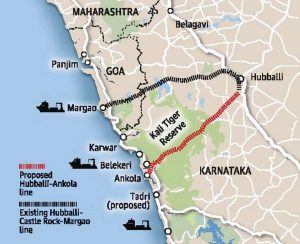HUBBALI-ANKOLA RAILWAY LINE – Destruction of Biodiversity hotspot!
The National Tiger Conservation Authority (NTCA) committee comprised Rajendra Garawad, Assistant Inspector General of Forests, NTCA Bengaluru Regional Office, R. Gopinath, Joint Director (Wildlife) and from MOEFCC, and Kaushik Banerjee from the Wildlife Institute of India. The report was submitted to the Ministry of Environment, Forest and Climate Change in August 2018 but could escalate manifold as the gestation period of the project spans about 8 to 10 years. The proposed railway line passes through different types of forests, including evergreen, semi-evergreen, moist deciduous, and dry deciduous forests with a high canopy density.
The overall floristic diversity comprises 43 families, 106 genera and 134 species of trees and 58 families, 128 genera and 146 species of woody ground flora of shrubs and regenerating tree stocks. Also, the highest percentage of evergreen trees were reported from Vajralli-Birgadde villages of Yellapur taluk, as per the authors of the report. They have pointed out that the forests along the proposed project zone is rich in fauna represented by 29 species of mammals, 256 species of birds, 8 species of reptiles, and 50 species of butterflies. “Majority of mammals belong to IUCN Red List and most of them are protected under the Wildlife Protection Act, 1972”.
The proposed 164.44-km railway line passes through forests between two major protected areas — Kali Tiger Reserve and Bedthi Conservation Reserve. More than 80% the line has to pass through the dense forest lands of the Western Ghats, and this entails the diversion of 727 hectares of prime forests.

The other reasons for rejecting the project was the presence of an ADB-funded road that was underutilized and projected decline in mining activity in the region which will render the project redundant.
Sources told The Hindu that the Chief Minister overruled various reports filed by environmental experts, including a comprehensive report filed by the National Tiger Conservation Authority (NTCA) representatives that the project was inimical to environment and the perceived economic gains would be neutralized by the immense environmental devastation.
The Chief Minister and the officials supportive of the project depended heavily on a report submitted by a scientist from Indian Institute of Science. But even senior Forest Department officials have dismissed the mitigation measures suggested by the IISc. scientist as highly impractical and unrealistic.
Steamrolling opposition to the Hubballi-Ankola railway line, Chief Minister B.S. Yediurappa cleared the controversial project at the State Wildlife Board meeting convened in Bengaluru on 20th March 2020.

State Boards for Wildlife:
- SBWL is constituted under the Wildlife Protection Act, 1972.
- The SBWL is headed by the Chief Minister, with the Forest Minister of the State as the Vice Chair.
- State Boards for Wildlife advises the state governments in selection and management of protected areas and other matters connected with the protection of wildlife.
Kali Tiger Reserve:
- Kali Tiger Reserve is located in the central portion of Uttara Kannada district of Karnataka state.
- The Tiger Reserve comprises two important protected areas of the region viz., Dandeli Wildlife Sanctuary and Anshi National Park.
- These two protected areas are contiguous to each other and form a single tract of the protected area located in the biologically sensitive Western Ghats.
- Forests of the Tiger Reserve are primarily moist deciduous and semi-evergreen, with excellent patches of evergreen forests in the western most parts as well as in deep valleys.
- Animals found in the Tiger Reserve include Tiger, Leopard, Elephant, Bison, Wild dog, Sambar, Spotted deer, Sloth bear, Wild boar, Hanuman langur, Bonnet macaque, varieties of reptiles and birds, etc.
Related sources:
 Creative Streaks
Creative Streaks






Most of the railway line and road construction projects are crossing the eco sensitive zones in India….if we disturb the nature, definitely it will backfire one day…. though always some questions r rolling over my head”whether sustainable development is possible” ?? How come without touching the natural resources, we can develop our country?? How to balance nature & country’s development??
Though its a bigger question rather topic, Below are my two cents!
#First and foremost we need to be less dependent on fossil fuels by doing so we can drastically reduce CO2 emmissions, air pollution and Global warming etc.
#Inventing more renewable energy sources like Solar at the same time concentrate and innovate more on these areas to reduce the overall cost (both production and storage)
#Afforestation to be encouraged by proper policies and mandates so that we could convert non-forest lands to forest lands and to create new avenues to maintain the biodiversity and ecological balances
#Always to need to take a balanced call based on the impact size and richness of the biodiversity, most of the times the benefit which we are going to get through a specific project would be very minimal when compared to the overall abundance which has been destroyed by means of flora, fauna and the local tribal population and their immense values of preserving the nature and having a lifestyle in tandem with nature, etc…
we as humans are capable of innovating more and more without devastating our nature but somehow we are also often looking for easy options and that mindset to be changed! the message has to be loud and clear like “No means a BIG NO in certain things!” most importantly on ecological and societal issues!
We must save forest for wildlife
Of course! this world is not only for humans…we’re the youngest and recent of the species on the Earth!